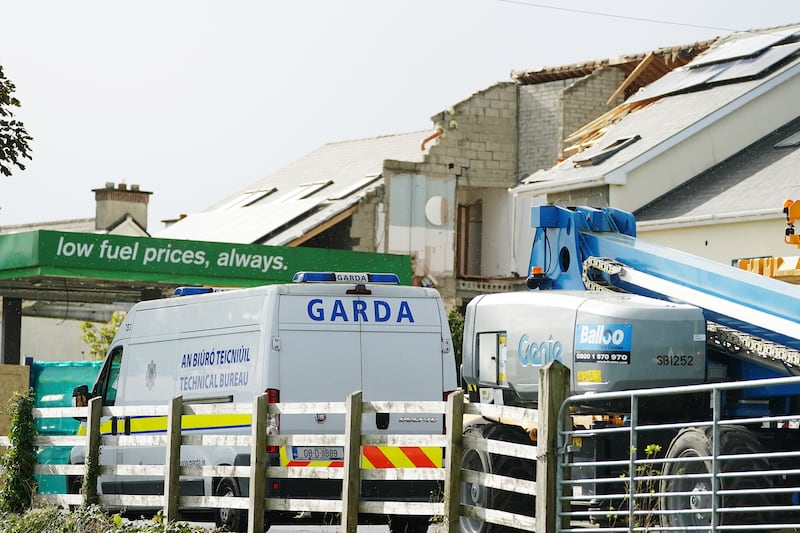I was getting on a flight when my girlfriend texted me: “Big explosion in Creeslough.” She’s from close by, Falcarragh, and the service station, with its bustling shop and post office (not merely a “petrol station”), is a familiar one.
I didn’t have much time to see what was happening, only hoping there weren’t too many people hurt. On the plane, I thought about Creeslough, the brilliant glamping site that has grown with the benefits of Wild Atlantic Way marketing and pandemic-era staycations, the spectacular white-sand local beaches that mark the coast, the beautiful Glenveagh National Park to the south. But mostly, I thought about the whitewashed walls of St Michael’s.
One of the most beautiful things about Creeslough is the local chapel, St Michael’s. It is stark white but utterly sympathetic to the landscape, curving with a sweeping softness to mimic Muckish Mountain. It was created by Liam McCormick, who designed seven modernist churches in Donegal. Burt is probably his most famous in the county, inspired by the Grianán Aileach ringfort, and echoes Donegal’s way of doing things differently; McCormick designed a church yet called it “my pagan building”.

But St Michael’s in Creeslough, I think, is the most beautiful. The small stained glass windows inspired by Donegal cottages, have gorgeous Helen Moloney stained glass art. The windows look small from the outside, but inside colour pours into each alcove. Most spectacularly, is the decision to leave the largest windows clear. There is no need for flourishes, because the view opens out to the Derryveagh mountains and Muckish itself. This simplicity, appreciation for surroundings, and recognition of beauty, is very Donegal, and emblematic of the county’s down-to-earthness.
‘Like the heart was ripped out of the village’: one year on from the Creeslough disaster
Creeslough: regeneration plan unveiled for Co Donegal village that suffered 2022 explosion
Creeslough: Woman who lost relatives in explosion says she would never enter shop built on site of tragedy
Ten people died in a furnace of twisted metal in Creeslough. Now the owner wants to build another filling station
And then I landed, turned on my phone, and the gravity of the tragedy became known to me. What can you even say? This is a horror. Sometimes we are going about our lives and all of a sudden every element of past, present and future rips open and devastation drops in. I cannot imagine how surreal and awful things have been this past weekend for the people of Creeslough.
How awful now, that northwest Donegal has all of the attention of the country and beyond through the lens not of joy and beauty, but of tragedy
The feeling of apartness in Donegal, particularly its northwest — a consequence of geographic location, sure, but also of constantly being ignored and even abandoned by national government — gives rise to a sort of tight-knit-ness that is, even in Irish terms, utterly unique. The brilliant, wry, cynical humour. The natural way people are with each other. The informality of not needing to dig into details of plans but just knowing they will unfold. The turning-up. The openness, bashfulness, kindness. The pride in doing things differently. There is an inclusive warmth within all of this independence, a self-sufficiency forged from that sense of not being heard. Any marginalised community can understand and appreciate this collective spirit. How awful now, that northwest Donegal has all of the attention of the country and beyond, through the lens not of joy and beauty, but of tragedy.
I don’t know what to say about grief that hasn’t been said before. Tragedy, especially, causes a visceral grief that sits on and underneath the skin. Tragedy is grotesque unfairness. When it strikes, it is unforgiving in its brutality. As I’ve gotten older, I’ve realised that there is often no “getting over” certain grief. There is only a long, hazy way through it. The fog may never lift completely, you just learn to navigate it. Being open about grief is the only thing that seems to help, so here is something I’ve learned about grief this year.
Earlier this year I lost a dear friend to suicide. Her death has shattered countless lives. Her spirit was so potent, so full of life, that the tragedy doesn’t abate. Even though we hadn’t spent time together in recent years, the volume of her absence can often feel like something over-pouring within me. As the months have passed, the grief hasn’t abated. It has merely deepened. I sometimes find sudden tears flowing when I’m just out for a walk. My stomach drops when I think I see her features in someone else’s face on the street. I stopped fighting the grief. It’s just part of life. Resisting it — as overwhelming, destabilising, and all-encompassing as it can be — would be an attempt to counter the reality of emotion. Because grief is really about love. The depth of one’s grief is one side of the scales, the other side of which is weighed down with love. They must balance, and that’s the price of living a life where love is felt. It is so unfair for that to be snatched brutally away and for grief to now fill the space.
I am so sorry for everyone who lost someone in Creeslough.
There is no closure with tragedy, but there can be comfort. The people of Creeslough and Donegal should know that the entire country mourns in shock and sadness with them. A shared comfort is a shouldered one, and the weight of it will be carried nationwide.















